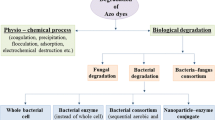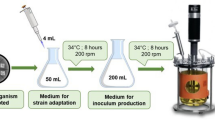Abstract
Bioremediation is considered a promising eco-efficient alternative for industrial wastewater treatment. Particular attention is currently being given to biological degradation of synthetic dyes and more specifically to colour removal by fungi. This work looks at the extracellular enzymatic system of strain Euc-1. Its ability to decolourize 14 xenobiotic azo dyes was evaluated and compared with the well-known species Phanerochaete chrysosporium. Strain Euc-1 is a mesophilic white-rot basidiomycete, the main secreted ligninolytic enzyme being laccase (0.38 U ml−1). Although low manganese-dependent peroxidase activity (0.05 U ml−1) was also detected, neither lignin peroxidase nor aryl alcohol oxidase could be found in batch culture. Optimum pH values of 4.0 and 5.0 were obtained in the laccase-catalysed oxidation of guaiacol and syringaldazine, respectively. Laccase activity increased with the temperature rise up to 50–60 °C and remarkable thermal stability was observed at 50 °C with a half-life of 12 h and no deactivation within the first 2 h. Solid-plate decolourization studies showed that basidiomycete Euc-1 decolourized 11 azo dyes whereas P. chrysosporium only two. Moreover, it is shown that purified laccase from basidiomycete Euc-1 efficiently decolourizes the azo dye acid red 88.
Similar content being viewed by others
References
Abadulla, E., Tzanov, T., Costa, S., Robra, K.-H., Cavaco-Paulo, A. & Gubitz, G.M. 2000 Decolourization and detoxification of textile dyes with a laccase from Trametes hirsuta. Applied and Environmental Microbiology 66, 3357–3362.
Bourbonnais, R., Paice, M.G., Reid, I.D., Lanthier, P. & Yaguchi, M. 1995 Lignin oxidation by laccase isozymes from Trametes versicolor and role of the mediator 2,2?-azinobis(3-ethylbenzthiazoline-6-sulfonate) in kraft lignin depolymerization. Applied and Environmental Microbiology 61, 1876–1880.
Breen, A. & Singleton, F.L. 1999 Fungi in lignocellulose breakdown and biopulping. Current Opinion in Biotechnology 10, 252–258.
Chivukula, M., Spadaro, J.T. & Renganathan, V. 1995 Lignin peroxidase-catalyzed oxidation of sulfonated azo dyes generates novel sulfophenyl hydroperoxides. Biochemistry 34, 7765–7772.
Cripps, C., Bumpus, J.A. & Aust, S.D. 1990 Biodegradation of azo and heterocyclic dyes by Phanerochaete chrysosporium. Applied and Environmental Microbiology 56, 1114–1118.
Dias, A.A., Bezerra, R.M. & Pereira, A.N. 2001 Decolourisation and dephenolisation of olive mill wastewater by a new laccase producing strain. Abstract PW10-015. European Journal of Biochemistry 268(suppl.), 238.
Eggert, C., Temp, U., Dean, J.F. & Eriksson, K.-E.L. 1996 A fungal metabolite mediates degradation of non-phenolic lignin structures and synthetic lignin by laccase. FEBS Letters 391, 144–148.
Gianfreda, L., Xu, F. & Bollag, J.-M. 1999 Laccases: a useful group of oxidoreductive enzymes. Bioremediation Journal 3, 1–25.
Gill, P.K., Arora, D.S. & Chander, M. 2002 Biodecolourization of azo and triphenylmethane dyes by Dichomitus squalens and Phlebia spp. Journal of Industrial Microbiology and Biotechnology 28, 201–203.
Goszczynski, S., Paszczynski, A., Pasti-Grigsby, M.B., Crawford, R.L. & Crawford, D.L. 1994 New pathway for degradation of sulfonated azo dyes by microbial peroxidases of Phanerochaete chrysosporium and Streptomyces chromofuscus. Journal of Bacteriology 176, 1339–1347.
Guillén, F., Martínez, A.T. & Martínez, M.J. 1992 Substrate specificity and properties of the aryl-alcohol oxidase from the ligninolytic fungus Pleurotus eryngii. European Journal of Biochemistry 209, 603–611.
Hatakka, A. 1994 Lignin-modifying enzymes from selected white-rot fungi: production and role in lignin degradation. FEMS Microbiology Reviews 13, 125–135.
Heinfling, A., Ruiz-Duenas, F.J., Martínez, M.J., Bergbauer, M., Szewzyk, U. & Martínez, A.T. 1998 A study on reducing substrates of manganese-oxidizing peroxidases from Pleurotus eryngii and Bjerkandera adusta. FEBS Letters 428, 141–146.
Hiratsuka, N., Wariishi, H. & Tanaka, H. 2001 Degradation of diphenyl ether herbicides by the lignin-degrading basidiomycete Coriolus versicolor. Applied Microbiology and Biotechnology 57, 563–571.
Karam, J. & Nicell, J.A. 1997 Potential applications of enzymes in waste treatment. Journal of Chemical Technology and Biotechnology 69, 141–153.
Kirby, N., Marchant, R. & McMullan, G. 2000 Decolourisation of synthetic textile dyes by Phlebia tremellosa. FEMS Microbiology Letters 188, 93–96.
Kirk, T.K. & Farrell, R.L. 1987 Enzymatic combustion: the microbial degradation of lignin. Annual Review of Microbiology 41, 465–505.
McMullan, G., Meehan, C., Conneely, A., Kirby, N., Robinson, T., Nigam, P., Banat, I.M., Marchant, R. & Smyth, W.F. 2001 Microbial decolourisation and degradation of textile dyes. Applied Microbiology and Biotechnology 56, 81–87.
Miller, G.L. 1959 Use of dinitrosalicylic acid reagent for determination of reducing sugar. Analytical Chemistry 31, 426–428.
Nagai, M., Sato, T., Watanabe, H., Saito, K., Kawata, M. & Enei, H. 2002 Purification and characterization of an extracellular laccase from the edible mushroom Lentinula edodes, and decolourization of chemically different dyes. Applied Microbiology and Biotechnology 60, 327–335.
Nyanhongo, G.S., Gomes, J., Gubitz, G.M., Zvauya, R., Read, J. & Steiner, W. 2002 Decolourization of textile dyes by laccases from a newly isolated strain of Trametes modesta. Water Research 36, 1449–1456.
Pelaez, F., Martinez, M.J. & Martinez, A.T. 1995 Screening of 68 species of basidiomycetes for enzymes involved in lignin degradation. Mycological Research 99, 37–42.
Pierce, J. 1994 Colour in textile effluents-the origins of the problem. Journal of the Society of Dyers and Colourists 110, 131–134.
Pointing, S.B. 2001 Feasibility of bioremediation by white-rot fungi. Applied Microbiology and Biotechnology 57, 20–33.
Pointing, S.B., Bucher, V.V.C. & Vrijmoed, L.L.P. 2000 Dye decolourization by sub-tropical basidiomycetous fungi and the effect of metals on decolorizing ability. World Journal of Microbiology and Biotechnology 16, 199–205.
Reddy, C.A. 1995 The potential for white-rot fungi in the treatment of pollutants. Current Opinion in Biotechnology 6, 320–328.
Rodríguez, E., Pickard, M.A. & Vazquez-Duhalt, R. 1999 Industrial dye decolourization by laccases from ligninolytic fungi. Current Microbiology 38, 27–32.
Schliephake, K., Mainwaring, D.E., Lonergan, G.T., Jones, I.K. & Baker, W.L. 2000 Transformation and degradation of the disazo dye Chicago Sky Blue by a purified laccase fromPycnoporus cinnabarinus. Enzyme and Microbial Technology 27, 100–107.
Stolz, A. 2001 Basic and applied aspects in the microbial degradation of azo dyes. Applied Microbiology and Biotechnology 56, 69–80.
Swamy, J. & Ramsay, J.A. 1999 The evaluation of white rot fungi in the decoloration of textile dyes. Enzyme and Microbial Technology 24, 130–137.
Tekere, M., Zvauya, R. & Read, J.S. 2001 Ligninolytic enzyme production in selected sub-tropical white rot fungi under different culture conditions. Journal of Basic Microbiology 41, 115–129.
Tien, M. & Kirk, T.K. 1988 Lignin peroxidase of Phanerochaete chrysosporium. Methods in Enzymology 161, 238–249.
Vyas, B.R. & Molitoris, H.P. 1995 Involvement of an extracellular H2O2-dependent ligninolytic activity of the white rot fungus Pleurotus ostreatus in the decolourization of Remazol brilliant blue R. Applied and Environmental Microbiology 61, 3919–3927.
Xu, F. 1996 Oxidation of phenols, anilines, and benzenethiols by fungal laccases: correlation between activity and redox potentials as well as halide inhibition. Biochemistry 35, 7608–7614.
Author information
Authors and Affiliations
Rights and permissions
About this article
Cite this article
Dias, A.A., Bezerra, R.M., Lemos, P.M. et al. In vivo and laccase-catalysed decolourization of xenobiotic azo dyes by a basidiomycetous fungus: characterization of its ligninolytic system. World Journal of Microbiology and Biotechnology 19, 969–975 (2003). https://doi.org/10.1023/B:WIBI.0000007331.94390.5c
Issue Date:
DOI: https://doi.org/10.1023/B:WIBI.0000007331.94390.5c




